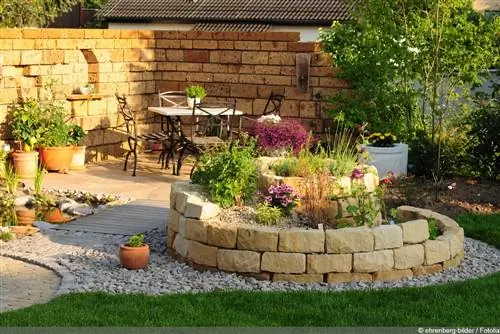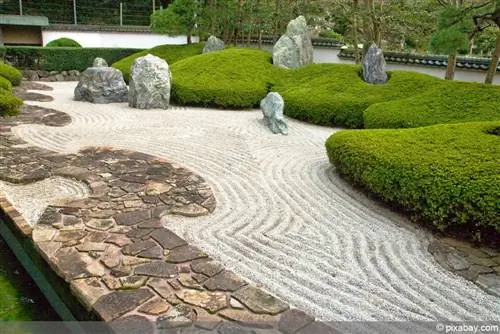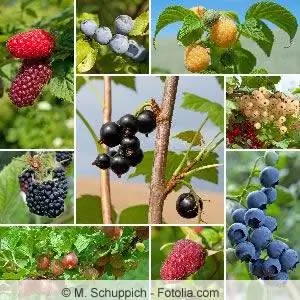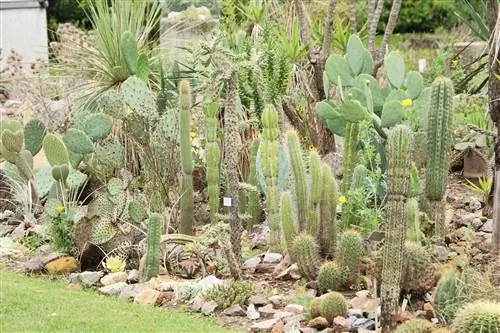- Author admin [email protected].
- Public 2023-12-17 03:39.
- Last modified 2025-01-24 12:45.
Once the foil or the stream channels have been laid out, another layer of gravel and stones should be filled in. This layer can be a good 10 cm, as plants can also be used here. The outlet of the stream should slope slightly upwards, this elevation should be approximately 20 cm. Because there is still water in the watercourse when the pump is switched off. This creates a small waterfall at the same time, which further underlines the harmony of the water. This splashing noise can really relax someone and perhaps calmly watch their neighbor mow their lawn. Because what's more fun than relaxing when others are struggling?
Good planning is important when it comes to watercourses
So that it doesn't become a traveling stream, the gradient should not be more than 4 cm per meter. This is extremely important because if the slope is less, the water will not drain properly and the stream will become more of a slow-moving puddle. Of course, the width is also an important point and, above all, what performance the pump has to deliver. All of this needs to be taken into account before the groundbreaking ceremony. Of course also how long the stream should be and this also includes the width. Everyone has their own scope here, because with a pond liner everyone is independent. When you start excavating, always dig out a little more so that you can work properly. Above all, stones and gravel are added and of course these also require space. For this purpose, you should plan at least 70 cm in width and at least 40 cm in depth. So it really becomes a watercourse that offers everything that relieves stress.
Curves not only help with harmony
A watercourse should not be built straight like a slide, but a few small curves not only loosen up the picture. Rather, the barrages and small curves ensure that it is a gently babbling watercourse and not a torrent. Of course, the barrages can also be planted, just like in nature. Since the water flows faster at the barrages, they must be well hidden under the film. Stones should also be placed here again so that the step is not washed away. Once everything is well covered and the pump is connected, water can be filled. Of course, some things can still be designed freely.
Things worth knowing about your own watercourse in the garden
You can create a watercourse in your garden very quickly yourself:
- The basis for this is a hill in the garden, which either already exists or has to be created with earth.
- Such a hill can then be wonderfully planted and the stream can be embedded harmoniously in it.
- You can start at the lower part of the belly run, where you dig out a small pond.
- This is then covered with foil and can be covered with stones on the sides.
- Now we have to find a place for the stream pump on this pond, which will then transport the water.
- It is advisable to construct a small wall behind which the pump can be hidden.
- Abdominal pumps are available in every pond specialist shop and cost around 300 euros, depending on the desired delivery height.
From the pond you then work your way up in terraces. This requires a belly channel to be dug out, which is also lined with foil. Don't forget the water hose and cable for the pump, which can be easily hidden under a layer of pebbles next to the stream. The terraced structure is ideal because the water remains in the belly channel even when the pump is not switched on and does not flow completely downwards. To make such a stream safe for children, deeper areas can be filled with gravel and stones. The most beautiful thing about a stream is the spring from which the water bubbles out and flows downwards. You can also quickly build such a source yourself:
- This requires a larger stone, which is drilled with a 10mm stone drill.
- The back side of the hole must then be enlarged so that a hose coupling fits in.
- The sealing is simply done with some Teflon sealing tape.
- Finally, all you have to do is connect the hose and the water can bubble.
If you don't like it that complicated, you can also buy sources from garden shops. Here there are fish heads or animal mouths from which water flows.






